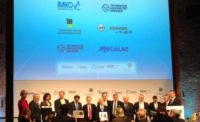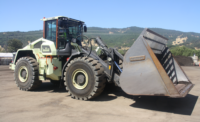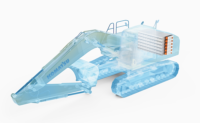When Komatsu rolled out its WA Electric wheel loader during demonstration sessions at the 2022 Bauma equipment trade show in Munich, Germany, last October, engineers and sales staff at the booth were not expecting the little machine to steal the show. But customers who came up afterward wanted to know if they could buy one on the spot, despite the “Prototype” label plastered all over the machine.
“The customers were very positive and enthusiastic about it,” recalls Michael Wadsack, product manager at Komatsu Europe. “We had some who wanted to buy it immediately without even hearing a price.” The surprising demand for a prototype put together in barely a year has given Komatsu another data point on how fast it can advance toward the equipment manufacturer’s stated goal of being carbon-neutral by 2050.
The WA Electric is the result of a collaboration with U.S.-based equipment electrification specialist Moog Construction. The company has already seen some success in an all-electric compact track loader developed with Bobcat Co., but the Komatsu effort has opened up new doors, says Eric Berg, system engineer at Moog. He says that while some electrification efforts by equipment makers swap out a diesel engine for a battery pack and call it a day, Moog goes a bit further. The WA Electric was a Komatsu wheel loader that was stripped down to bare steel, to the point where the hydraulic system has been replaced with electric-driven actuators.
That’s where it gets interesting, says Berg. “With Bobcat and Komatsu, we convert them to fully electric, and you instantly get this robotic capability,” he explains. The precision of going entirely electric solves some of the issues with automation. “Now all of your axes can be controlled by a computer, and with the right sensors you can actually design high-level autonomy around this system,” says Berg.
While the potential for automation is on the horizon, Komatsu now is exploring electrification in greater depth. The response at Bauma has prompted the company to advance plans to bring in customers to test the prototype for feedback, after a trip to CONEXPO-CONAGG in March, says Joerg Hermanns, general manager for R&D construction at Komatsu’s European Technical Center in Hanover, Germany. “Here at our proving ground we want to test it in real conditions, and invite some special customers to test it out in Hanover.”
By switching out the hydraulics for electric actuators, Hermanns sees a lot of potential for “tuning” the machine to different applications and operator styles. “Some operators might want a more aggressive machine with more acceleration, but an operator who has run the same diesel machine for thirty years can have it run that way—electrification makes that possible,” he says. The chance to have a single machine that can load up different driver performance preferences with the tap of a touchscreen also makes it an attractive option for the rental market, Hermanns adds. But he says the product development path will be driven by customer feedback during upcoming testing.
As with other efforts to move away from internal combustion engines in construction equipment, there are obvious benefits—meeting restrictions on emissions and noise levels in some markets, as well as possibilities opened by being able to operate the machines indoors.
But despite a rosy reception at trade shows, going fully electric is not without its drawbacks. Hermanns is quick to point out that some of the more demanding attachments available for this size of wheel loader would not be able to draw enough power from the current electric prototype. “Customers will have to understand they have to operate the machine in a different way,” he says. Komatsu also is not currently discussing a price for a commercialized version of the electric wheel loader, but Wadsack acknowledges there would be a price premium for going electric.
Even so, there is a view beyond the first prototype. “This electric machine will be part of a road map: it’s not the only solution,” says Wadsack. Komatsu is investing in alternative fuels such as hydrogen, and has already introduced smaller electric equipment in some markets. “The reaction[to the WA Electric] so far has been so positive and excited. Now we want to see how we can take it to market.”






Post a comment to this article
Report Abusive Comment